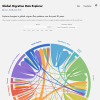
IIASA researchers developed a tool to help address the lack of data on global migration flows and provide a visual method for exploring migration patterns worldwide.
The Global Migration Data Explorer builds on the success of its predecessor, the Global Flow of People, which estimates migration flows between and within regions from 1990 to 2010.
The new version incorporates estimates until 2020, based on advanced estimation methods, and expands the scope to include different migration measures and breakdowns of migration patterns by sex.
“International migration is becoming an increasingly important component of population growth and a driver for socioeconomic change,” explains IIASA researcher Guy Abel who co-developed the tool. “The Global Migration Data Explorer fills a critical gap by providing estimates of migration flows that are invaluable to researchers studying migration systems, demographics, employment, climate change, and epidemiology.”
The explorer incorporates UN estimates of foreign-born populations, considered the most reliable source of data on global migration. While the UN data provides a snapshot of population migration at a specific point in time, the flow estimates offer a period measure of migration, making them more valuable for researchers investigating the causes and consequences of migration.
“It is rewarding to hear that schoolteachers have expressed their interest in using the website to educate their students, highlighting the need for up-to-date data and the applicability of the tool beyond academia,” concludes IIASA Population and Just Societies Program Director, Anne Goujon.
